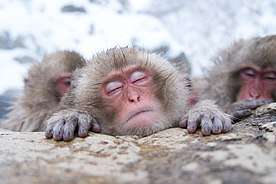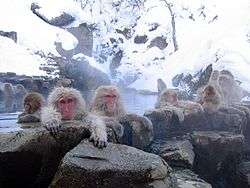Jigokudani Monkey Park
Jigokudani Monkey Park (地獄谷野猿公苑, Jigokudani Yaen Kōen) is located in Yamanouchi, Nagano Prefecture, Japan. It is part of the Joshinetsu Kogen National Park (locally known as Shigakogen), and is located in the valley of the Yokoyu-River, in the northern part of the prefecture. The name Jigokudani, meaning "Hell's Valley", is due to the steam and boiling water that bubbles out of small crevices in the frozen ground, surrounded by steep cliffs and formidably cold and hostile forests.[1]
| Jigokudani Monkey Park | |
|---|---|
The valley base of Jigokudani | |

| |
| Location | Yamanouchi, Shimotakai District, Nagano Prefecture, Japan |
| Coordinates | 36°43′59″N 138°27′48″E |
The heavy snowfalls (snow covers the ground for four months a year), an elevation of 850 m (2,800 ft), and being only accessible via a narrow 2 km (1.2 mi) footpath through the forest, keep it uncrowded despite being relatively well known.
It is famous for its large population of wild Japanese macaques (Macaca fuscata), more commonly referred to as snow monkeys, that go to the valley during the winter, foraging elsewhere in the national park during the warmer months. The monkeys descend from the steep cliffs and forest to sit in the warm waters of the onsen (hotsprings), and return to the security of the forests in the evenings.
However, since the monkeys are fed by park attendants, they are in the area of the hot springs all the year round, and a visit at any season will enable the visitor to observe hundreds of the macaques.[2]
Jigokudani is not the farthest north that monkeys live. The Shimokita Peninsula is at the northern part of the Honshū island and the northwest area of this peninsula, latitude +41°31' longitude +140°56', approximately 500 km (310 mi) north from Jigokudani is the northern limit of Japanese macaque habitat. No (non-human) primate is known to live in a colder climate.[3][4][5][6]
The Jigokudani monkey park became famous after appearing in the documentary Baraka.

Gallery
_im_Jigokudani_Yaen_K%C5%8Den%2C_Japan.jpg) Headshot of a Japanese macaque at Jigokudani Monkey Park
Headshot of a Japanese macaque at Jigokudani Monkey Park
_im_Jigokudani_Yaen_K%C5%8Den.jpg) Young Japanese macaque at the Jigokudani Monkey Park
Young Japanese macaque at the Jigokudani Monkey Park An alpha male at the Jigokudani Monkey Park
An alpha male at the Jigokudani Monkey Park
References
- Scheffel, Richard L.; Wernet, Susan J., eds. (1980). Natural Wonders of the World. United States of America: Reader's Digest Association, Inc. pp. 193. ISBN 0-89577-087-3.
- Jigokudani Monkey Park (Yaen-Koen) Official Site |title= Jigokudani Yaen-Koen Official Page
- Explore the Heart of Japan - Snow Monkeys
- Masahiro Minami. "Profile of Japanese macaques". Simon Fraser University. Archived from the original on October 24, 2009. Retrieved 2014-03-11.
- Masui, K. (1988). Nihonzaru no fudo, Climatology of Japanese Macaque, Tokyo.
- Yuzankaku; Nakagawa, N., Iwamoto, T., Yokota, N., & Soumah, A.G. (1996). Inter-regional and inter-seasonal variations of food quality in Japanese macaques: constraints of digestive volume and feeding time. Cambridge University Press. pp. 207–234. ISBN 9780521021715.
In J.E. FA., & D.G. Lindburg (Eds.), Evolution and ecology of macaque societies
CS1 maint: uses authors parameter (link)
External links
| Wikimedia Commons has media related to Jigokudani Monkey Park. |
| Wikispecies has information related to Japanese macaque |